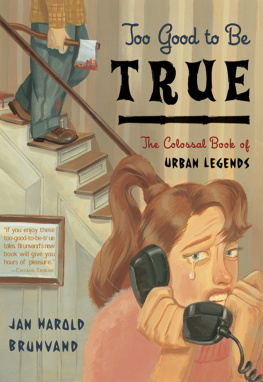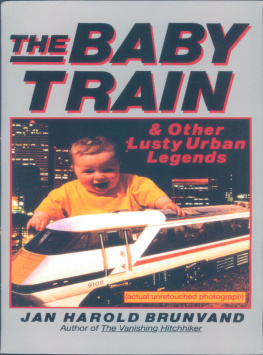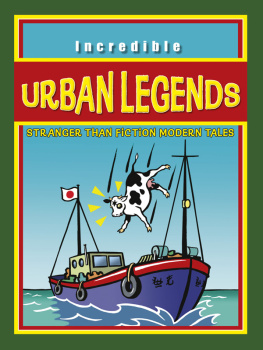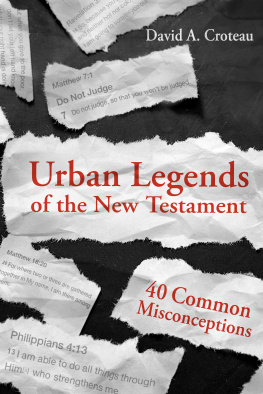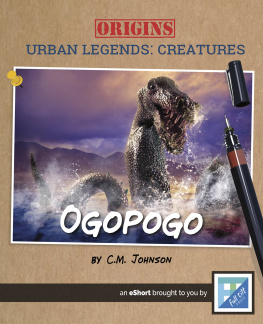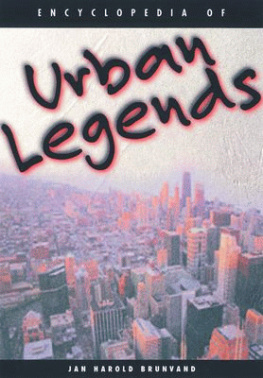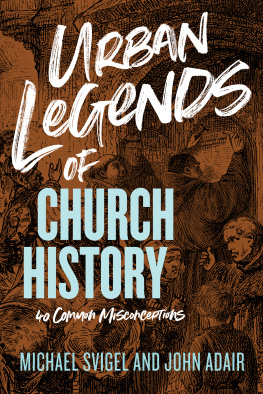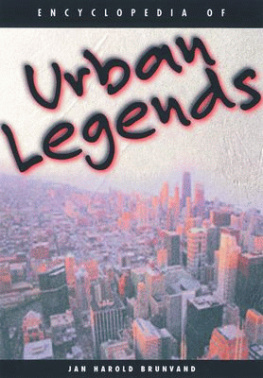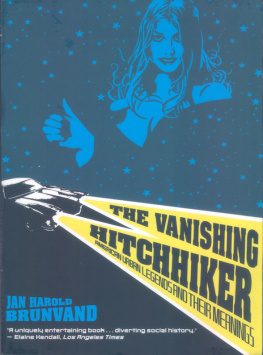Too Good to Be True
The Colossal Book of Urban Legends
Jan Harold Brunvand

Copyright 1999 by Jan Harold Brunvand
All rights reserved
The Nude in the RV: reprinted with the permission of Simon & Schuster from TheWeekend Camper by Dan and Inez Morris. Copyright 1973 by Dan and Inez Morris. The Arrest, The Bedbug Letter, and The Flying Kitten: 1986, 1987, and 1993 the Washington Post. Reprinted with permission. The Blind Man and The Blind Date: Permission granted by Ann Landers and Creators Syndicate.The Videotaped Theft and The Bullet Baby are taken from a Dear Abby column by Abigail Van Buren. Reprinted with permission of Universal Press Syndicate. All rights reserved. Excerpt in Urban Legend Parodies 1990 by Dave Barry. Reprinted by permission of the author. Alligators in the Sewers copyright 1982 by the New York Times. Reprinted by permission.
For information about permission to reproduce selections from this book, write to Permissions, W. W. Norton & Company, Inc., 500 Fifth Avenue, New York, NY 10110
Chapter opening illustrations as well as illustrations on the following Chapters by Michael Wood: Chapter 1, Chapter 2, Chapter 4, Chapter 6, Chapter 8, Chapter 11, Chapter 12, Chapter 13, Chapter 14, Chapter 15, Chapter 16, Chapter 17, Chapter 21, Chapter 22, Epilogue
Library of Congress Cataloging-in-Publication Data
Brunvand, Jan Harold.
Too good to be true : the colossal book of urban legends / Jan
Harold Brunvand.
p. cm.
ISBN 0-393-04734-2
1. Urban folkloreUnited States. 2. LegendsUnited States. 3. Urban folklore. 4. Legends. I. Title.
GR105.B715 1999
398.2'0973'091732dc21 99-17562
W. W. Norton & Company, Inc., 500 Fifth Avenue, New York, N.Y. 10110
www.wwnorton.com
W. W. Norton & Company Ltd., 10 Coptic street, London WC1A 1PU
Scholar Jan Brunvand calls tales of fatal
Pop Rocks candy & hook-handed
molesters this kind of legend.
Question: What is urban?
(Topic on Jeopardy, October 24, 1997)
Contents
A Note on Texts and Sources
The letters quoted in this book came from readers of my five previous urban legend collections (1981 to 1993) and of my syndicated newspaper columns (1987 to 1992) who responded to my invitations published there to contribute stories they had heard. In quoting urban legends from these letters, I have sometimes made slight changes in punctuation, spelling, or usage in order to present a consistent style throughout the book. Occasionally I have inserted information from the longer letter in order to clarify points mentioned in the stories themselves, but I have not combined story texts, deleted details, or added anything to the plots of the stories. I give the name of the writer, his or her location, and the date of each letter quoted; however, some of my contributors may have changed their names or moved since writing to me. The stories selected, in every instance, are typical of a wider tradition represented by other versions of the same legends in my files.
Besides the people named in notes to individual legends, I wish to thank the following for material supplied, services rendered, and general support of my work on this book: David Baker, Mac Barrick, Mike Bell, Meg Brady, Simon Bronner, Rich Buhler, Mary Carroll, Terry Chan, Tad Cook, Neal Coulter, Norine Dresser, Bill Ellis, Gary Alan Fine, Joe Goodwin, Harriet A. Hall, Mary Anne Hill, Ann Jarvis, John Johansen, R. R. Kohout, Janet Langlois, Jens Lund, Bill McNeill, Joey Meyer, Barbara and David Mikkelson, C. Claiborne Ray, Michael Richerson, David Rockhill, Peter Samuelson, Cynthia Scheer, John Schleppenbach, Sharon Sherman, Steve Siporin, Paul Smith, David Stanley, Steve Terrell, Barre Toelken, Patricia Turner, Eugene G. Weinberg, Valerie Westcott, Dan Wilson, William A. Wilson, Sue Wolfe, and Ed Zotti.
A special thanks to my tactful, wise, and expert editor Amy Cherry, whose eagle eye for detail is legendary. Without her, I would have let many embarasing misteaks get into print.
Introduction
True Stories, Too Good to Be True
Urban legends (ULs) are true stories that are too good to be true. These popular fables describe presumably real (though odd) events that happened to a friend of a friend. And they are usually told by credible persons narrating them in a believable style because they do believe them. The settings and actions in ULs are realistic and familiarhomes, offices, hotels, shopping malls, freeways, etc.and the human characters in urban legends are quite ordinary people. However, the bizarre, comic, or horrifying incidents that occur to these people go one step too far to be believable.
For example, in some well-known ULs people do things like fill cars with cement, microwave their pets, get bitten by poisonous snakes concealed in imported garments, lose their grandmothers corpse from the car roof, buy a Porsche for a mere $50, mistake a rat for a stray Chihuahua, sit on an exploding toilet, steal a package that contains only a dead cat, get caught in the nude by a gas-meter reader, or snag a tablecloth in a pants zipper, just to mention a few typical plots. All of these things could conceivably happen, but it is thoroughly unlikely that they really did happen in all the different times and places that the legend-tellers describe.
Urban legends are also too neatly plotted to be believed. Nothing is extraneous; everything in the story is relevant and focused on the conclusion. Thus, theyre too weird and coincidental to be absolute truth, especially considering that the same stories are attributed to many different settings, yet each telling of an urban legend is presumably about something that really happened to a friend of a frienda FOAF, as we folklorists say. In short, ULs are just too darn good that is, polished, balanced, focused, and neatto be true.
But its not really truth or fiction that defines an urban legend. As with any folkloreand these stories are definitely part of our modern folklorethe defining qualities are oral repetition and variation. As folk stories are repeated from person to person, and even to some degree in printed circulation, they constantly change in minor details while retaining a consistent narrative core. Heres an example taken from published sources sent to me by Charles D. Poe of Houston, Texas, an inveterate collector of the echoes of folklore in print and one of my favorite correspondents since I got into the UL business. For years Poe has been regularly sending me four-by-six envelopes stuffed with photocopies of dozens of bizarre published items, which he has liberally highlighted in glowing colors and to which he has added inked comments in red in the margins. In my Poe file, I found these three accounts of something witty that different American astronauts supposedly said:
- Was it, as one 1978 source claimed, Apollo 15 astronaut David Scott who remarked about his thoughts before launch, You just sat there thinking that this piece of hardware had 400,000 components, all of them built by the lowest bidder?
- Or was it Walter Schirra who, according to a 1980 report, phrased the idea, Just think, Wally, everything that makes this thing go was supplied by the lowest bidder?

